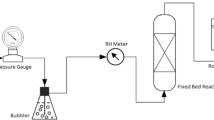Abstract
In areas of high-volume traffic, such as the proximities of expressways in large urban areas, the amounts of nitrogen oxides (NOx) emitted into the atmosphere significantly contribute to air pollution. As NOx gas is a major cause of smog and acid rain, this pollutant is considered to be particularly harmful, and therefore, increasing attention has been focused worldwide on the elimination of NOx from the air. Titanium dioxide (TiO2), a photocatalytic reaction material, is particularly effective in the removal of NOx. As the solar photocatalytic reaction of TiO2 is the mechanism that eliminates NOx, the TiO2 in concrete road structures needs to be exposed to the ultraviolet rays (UV) of sunlight to be activated. Generally, TiO2 concrete is produced by replacing a portion of the concrete binder with TiO2. However, a considerable amount of the TiO2 in the concrete is not exposed to either the air pollutants or the UV. Therefore, as an alternative method, surface penetration agents are used to add TiO2 to the surface of the concrete structure. This study aims to evaluate the in-situ NOx removal efficiency of the TiO2 penetration method in a field application. Accordingly, the TiO2 penetration method was tested on the retaining wall of the Gyeongbu expressway in Korea. The results of this study indicated that the quantity of sunlight influenced the NOx removal efficiency rate. Furthermore, it was c that the TiO2 penetration method can be an alternative to the existing TiO2 concrete, which produced by replacing a portion of the concrete binder with TiO2, for removing NOx gas from the air.
Similar content being viewed by others
References
Ballari, M. M., Hunger, M., Hüsken, G., and Brouwers, H. J. H. (2010). “NOx photocatalytic degradation employing concrete pavement containing titanium dioxide.” Applied Catalysis B: Environmental, vol. 95, no. 2010, pp. 245–254, DOI: 10.1016/j.apcatb.2010.01.002.
Beeldens Anne (2006). “An environmental friendly solution for air purification and self-cleaning effect: The application of TiO2 as photocatalyst in concrete.” TRA-Transport Research Arena Europe 2006, Gothenburg, Sweden.
Delany, A. C., Dickerson, R. R., Melchior, F. L., and Eartburg, A. F. (1982). “Modification of a commercial NOx detector for high sensitivity.” Rev Sci Instrum, vol. 12, no. 53, pp. 1899–1902, DOI: 10.1063/1.1136901.
Fujishima, A., Hashimoto, K., and Watanabe, T. (1999). TiO 2 Photocatalysis fundamentals and applications, Chiyoda-ku, Tokyo.
Hashimoto, K., Wasada, K., Toukai, N., Komonami, H., and Kera, Y. (2000). “Photocatalytic oxidation of nitrogen monoxide over titanium (IV) oxide nanocrystals large size areas.” J. Photochem Photobiol A Chem, vol. 136, pp. 103–109, DOI: 10.1016/S1010-6030(00)00329-4.
Hong, S. J. and Lee, S. W. (2013). “An experimental study of the construction of Photocatalytic method concrete road structure.” International Journal of Highway Engineering, Korea Society of Road Engineers, vol. 15, no. 6, pp. 1–9, DOI: 10.7855/IJHE.2013. 15.6.001, Seoul, Korea (in Korean).
ISO 22197-1 (2007). Test method for air-purification performance of semiconducting photocatalytic materials-Part 1: Removal of nitric oxide, First edition, International Organization for Standardization.
Kim, Y. K., Hong, S. J., Lee, K. B., and Lee, S. W. (2014). “Evaluation of NOx removal efficiency of Photocatalytic concrete for road structure.” International Journal of Highway Engineering, Korea Society of Road Engineers, vol. 16, no. 5, pp. 49–58, DOI: 10.7855/IJHE.2014.16.5.049, Seoul, Korea (in Korean).
Yu Jimmy Chai-Mei (2002). Ambient Air Treatment by Titanium Dioxide (TiO 2 ) based Photocatalyst in Hong Kong, Technical report, Environmental Protection Department, Hong Kong Special Administrative Region.
Author information
Authors and Affiliations
Corresponding author
Rights and permissions
About this article
Cite this article
Kim, Y.K., Hong, S.J., Kim, H.B. et al. Evaluation of In-Situ NOx Removal Efficiency of Photocatalytic Concrete in Expressways. KSCE J Civ Eng 22, 2274–2280 (2018). https://doi.org/10.1007/s12205-017-0028-9
Received:
Accepted:
Published:
Issue Date:
DOI: https://doi.org/10.1007/s12205-017-0028-9




